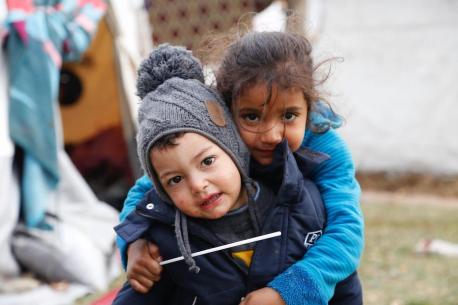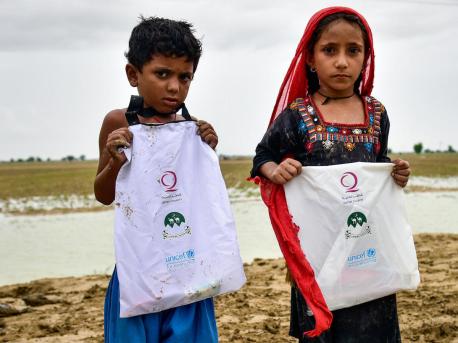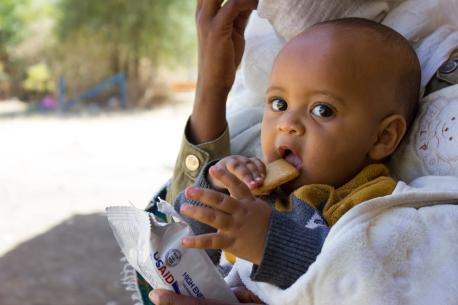Children under siege: Sahel food crisis worsening
Walking through the door into the intensive care ward, I am struck by sensory overload – children’s cries come seemingly from every direction; medical staff buzzing around me, inserting a feeding tube here, testing for malaria there; and an oppressive 104 degree heat from which there is no escape. This is the Intensive Nutritional Rehabilitation Center (CRENI) in the village of Madarounfa, south-eastern Niger, a hospital where children under age 5 are treated for severe acute malnutrition with complicating medical conditions. I have been here before, but somehow it has been transformed. Apart from the building structure itself and the familiar faces of the doctors and nurses, it is a different place entirely, almost unrecognizable. As I adjust to the scene around me, I realize what has changed. When I was here three months ago, there were only six children undergoing treatment for severe acute malnutrition. Today, all 28 hospital beds are occupied.
It is a microcosm of the worsening crisis across the Sahel region of Africa, where drought, poor harvests and rising food prices have left an estimated 1 million children at risk of death from malnutrition.
UNICEF Communication Specialist Chris Tidey travelled to Niger to assess the situation of families, especially children and women, amid the Sahel region’s intensifying nutrition crisis.
Walking through the door into the intensive care ward, I am struck by sensory overload – children’s cries come seemingly from every direction; medical staff buzzing around me, inserting a feeding tube here, testing for malaria there; and an oppressive 104 degree heat from which there is no escape.
This is the Intensive Nutritional Rehabilitation Center (CRENI) in the village of Madarounfa, south-eastern Niger, a hospital where children under age 5 are treated for severe acute malnutrition with complicating medical conditions.
I have been here before, but somehow it has been transformed. Apart from the building structure itself and the familiar faces of the doctors and nurses, it is a different place entirely, almost unrecognizable.
As I adjust to the scene around me, I realize what has changed. When I was here three months ago, there were only six children undergoing treatment for severe acute malnutrition. Today, all 28 hospital beds are occupied.
It is a microcosm of the worsening crisis across the Sahel region of Africa, where drought, poor harvests and rising food prices have left an estimated 1 million children at risk of death from malnutrition.
Fifteen-month old Habibou is severely malnourished and also suffers from malaria, anaemia and dehydration. His frail body is covered with lesions and he labors to breathe. Habibou weighs 9.9 pounds; a child his age and height should weigh at least 22 pounds. His mother brought him here three days ago from neighboring Nigeria after he stopped eating and developed a fever. I cannot remember ever seeing a child so ill.
 I next meet Aboubakar, 13 months old, who is being treated for severe acute malnutrition, a diarrheal infection and oral lesions. When he was admitted to the medical center last month, he weighed 11.6 pounds. He has since gained a pound through a regime of therapeutic milk provided by UNICEF.
“Aboubakar is sick because we don’t have enough food to eat in our village. I had to pay 1,000 francs to bring him here on motorbike from Nigeria,” says his mother, Hassia. Aboubakar is the youngest of Hassia’s four children, two of whom have died.
In January 2011, there were 77 admissions to the Madarounfa CRENI for the treatment of severe acute malnutrition with complications. In March, the number of admissions was a staggering 177.
According to UN experts, successive droughts in 2005, 2010 and this year, combined with increasing insecurity in the region, are pushing families to the brink. Some 15 million people are directly affected.
In Niger, more than 5 million people are facing food shortages – approximately 35% of the country’s entire population. UNICEF and its partners estimate that nearly 394,000 children in Niger will need to be treated for severe acute malnutrition this year.
As the crisis intensifies, increasing numbers of families are being displaced, forced to leave their homes in search of food and work.
Six months ago, Amina Abdou moved her family of four from their village in south-western Niger to the capital city, Niamey, because they had run out of food. She and her children are now living in makeshift shelters built of rags, sticks and tarpaulins at an informal site for displaced families.
“We had to leave our village of Damana because my husband died and there was no one to grow food,” she explains. “If we had stayed, we wouldn’t have survived.”
Twelve-year-old Oumar Soumana, from the village of Semana, moved to Niamey with his older sister and friends several months ago. He spends his days selling frozen juice on the road, and sends the earnings to his parents.
“I used to go to school in my village, but I had to leave so that I could work here in the city so my family can eat back home,” says Oumar. “I want to go back to school because with an education, you can get a good job and better quality of life.”
Nationwide, more than 33,000 children have dropped out of school following the poor agricultural yields. Prolonged interruption of school attendance can undermine a child’s future opportunities, continuing the cycle of poverty.
UNICEF is expanding the capacity of therapeutic feeding centers to treat severe acute malnutrition.
UNICEF is also increasing access to safe water and sanitation to prevent the spread of opportunistic diseases. UNICEF programs are also assisting displaced women and children and supporting a community-based health program to improve basic hygiene and nutrition practices for children and women.
The Consolidated Appeal launched by humanitarian actors in Niger requests US$229 million to respond to this emergency. UNICEF and its partners are calling on the international community to mobilize all means necessary to make sure that this threat to the lives of hundreds of so many children is averted.
It is not too late, but we must act now.
I next meet Aboubakar, 13 months old, who is being treated for severe acute malnutrition, a diarrheal infection and oral lesions. When he was admitted to the medical center last month, he weighed 11.6 pounds. He has since gained a pound through a regime of therapeutic milk provided by UNICEF.
“Aboubakar is sick because we don’t have enough food to eat in our village. I had to pay 1,000 francs to bring him here on motorbike from Nigeria,” says his mother, Hassia. Aboubakar is the youngest of Hassia’s four children, two of whom have died.
In January 2011, there were 77 admissions to the Madarounfa CRENI for the treatment of severe acute malnutrition with complications. In March, the number of admissions was a staggering 177.
According to UN experts, successive droughts in 2005, 2010 and this year, combined with increasing insecurity in the region, are pushing families to the brink. Some 15 million people are directly affected.
In Niger, more than 5 million people are facing food shortages – approximately 35% of the country’s entire population. UNICEF and its partners estimate that nearly 394,000 children in Niger will need to be treated for severe acute malnutrition this year.
As the crisis intensifies, increasing numbers of families are being displaced, forced to leave their homes in search of food and work.
Six months ago, Amina Abdou moved her family of four from their village in south-western Niger to the capital city, Niamey, because they had run out of food. She and her children are now living in makeshift shelters built of rags, sticks and tarpaulins at an informal site for displaced families.
“We had to leave our village of Damana because my husband died and there was no one to grow food,” she explains. “If we had stayed, we wouldn’t have survived.”
Twelve-year-old Oumar Soumana, from the village of Semana, moved to Niamey with his older sister and friends several months ago. He spends his days selling frozen juice on the road, and sends the earnings to his parents.
“I used to go to school in my village, but I had to leave so that I could work here in the city so my family can eat back home,” says Oumar. “I want to go back to school because with an education, you can get a good job and better quality of life.”
Nationwide, more than 33,000 children have dropped out of school following the poor agricultural yields. Prolonged interruption of school attendance can undermine a child’s future opportunities, continuing the cycle of poverty.
UNICEF is expanding the capacity of therapeutic feeding centers to treat severe acute malnutrition.
UNICEF is also increasing access to safe water and sanitation to prevent the spread of opportunistic diseases. UNICEF programs are also assisting displaced women and children and supporting a community-based health program to improve basic hygiene and nutrition practices for children and women.
The Consolidated Appeal launched by humanitarian actors in Niger requests US$229 million to respond to this emergency. UNICEF and its partners are calling on the international community to mobilize all means necessary to make sure that this threat to the lives of hundreds of so many children is averted.
It is not too late, but we must act now.

Aboubakar, 13 months, is treated for severe acute malnutrition with therapeutic milk, provided by UNICEF, at the hospital of in Madarounfa, Niger. UNICEF and its humanitarian partners in Niger now estimate that nearly 394,000 children will need to be treated for severe acute malnutrition over the course of the year. | © UNICEF/Niger/2012/CTidey


